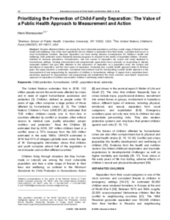Abstract: Disaster-affected children are among the most vulnerable populations and face a wide range of threats to their health and wellbeing. One of the most significant risks to children is separation from their family, a problem that occurs in most humanitarian contexts. Because separation can have lasting adverse consequences for children’s health and wellbeing, child protection actors frequently develop programs to respond to the needs of separated children. However, methods to measure prevalence, characteristics, and root causes of separation are scarce and rarely deployed in humanitarian settings. Existing measurement and programmatic approaches focus primarily on responding to already separated children and give little attention to the prevention of separation at a population level, the context and prevalence of separation, and the root causes of separation. Analyzing how a public health approach helps to fill these gaps, this paper presents a systematic, conceptual and practical case for incorporating a public health approach in the measurement of and programming for separation of children in humanitarian settings. It argues that a population-level, preventive approach to measurement and programming will complement the more common case-based, responsive approach to separation of children and enables children’s well-being amidst adversity.

